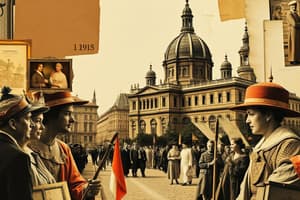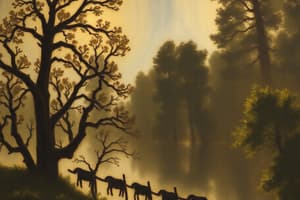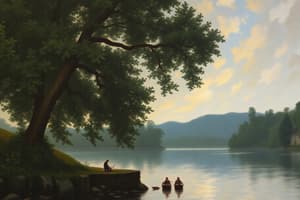Podcast
Questions and Answers
What is the primary purpose of CamScanner?
What is the primary purpose of CamScanner?
- To create digital pictures
- To scan documents and convert them to digital format (correct)
- To send fax documents electronically
- To edit images and videos
Which feature is NOT commonly associated with CamScanner?
Which feature is NOT commonly associated with CamScanner?
- Document enhancement and cropping
- Real-time collaboration with others (correct)
- Automatic cloud storage integration
- Optical Character Recognition (OCR)
Which file format can CamScanner export documents to?
Which file format can CamScanner export documents to?
- HTML
- MP3
- JPEG (correct)
- DOCX (correct)
What functionality does CamScanner offer for enhancing scanned images?
What functionality does CamScanner offer for enhancing scanned images?
Which of the following best describes the user interface of CamScanner?
Which of the following best describes the user interface of CamScanner?
Flashcards
CamScanner
CamScanner
A mobile app that allows users to scan documents, photos, and other physical content into digital formats.
Digital scanning
Digital scanning
The process of converting physical documents or images into digital files.
Digital formats
Digital formats
Types of computer-readable files, such as PDF, JPG, or PNG, that represent scanned content.
Mobile app
Mobile app
Signup and view all the flashcards
Scan documents
Scan documents
Signup and view all the flashcards
Study Notes
The Renaissance
- A cultural and intellectual movement in Europe from the 14th to 17th centuries, beginning in Italy.
- "Renaissance" means "revival" or "rebirth" referring to the revival of ancient Greco-Roman civilization.
- Europeans innovated and carried forward classical civilization, creating a transitional period from Medieval to Modern Times.
- Europeans revived ancient Greco-Roman theories and art styles in their works.
- Italy was the birthplace of the Renaissance.
Main Features of the Renaissance
- Revival of the ancient Greco-Roman civilization.
- Emphasis on humanism, focusing on worldly affairs with humans at the center.
- Challenging tradition, advocating for inquiry and rational thinking, and proposing new ideas.
- Decline of feudal society; Many peasants left for towns and became freemen, gaining greater freedoms and time for arts and learning.
- Rise of wealthy city-states and class: Trading centers developed rapidly, Italian city-states became major trading centers between Europe and Asia. Wealthy merchants and bankers emerged, with money to support art and science.
- Spread of eastern knowledge: Arab scholars' knowledge of science, mathematics, medicine, and astronomy was introduced to Europe through the Crusades.
- Rise of universities: Universities were built by governments or merchants, offering education in subjects beyond Biblical teachings (medicine, law, philosophy). They kept books related to the ancient Greco-Roman civilization.
Causes of the Renaissance
- Decline of feudal society, encouraging the move to towns.
- Increased freedom, and opportunity for people, allowing them more time for learning.
The Reformation
- A religious movement in Europe during the 16th and 17th centuries, causing a split in the Christian Church, reforming the Roman Catholic Church.
- Christians studied and amended early Bible copies, finding inaccuracies in the Latin Bible and Church's misinterpretations of Christian doctrines.
- 1516: Dutch theologian Erasmus published the original Greek version of the New Testament.
- Rulers discontented with the Church's great political power, wishing to regain their powers.
- Church corruption: The Church sold indulgences, claiming they could reduce the sufferings of purchasers and their relatives in purgatory.
Developments in Literature
- Literature changed in the Renaissance, moving from religious works (biographies of saints, prayers, hymns) written in Latin to worldly works (poems, novels, plays) written in the author's native languages.
- Writers were influenced by humanism, writing about worldly themes and human affairs.
Developments in Art
- Medieval paintings were mainly religious and not realistic.
- Renaissance paintings were diverse, three-dimensional, realistic, using new techniques (perspective, shadowing).
- Artists like Leonardo da Vinci, Michelangelo, and Raphael were noted for their works.
Developments in Architecture
- Early medieval buildings followed the Gothic style, with tall pointed towers, pointed arches, flying buttresses and stained glass.
- Renaissance architecture was proportional, harmonious, and rational, mirroring the human body, inspired by ancient Greco-Roman architecture.
Developments In Natural Science
- The Church's interpretation of science was integrated with theology, claiming that diseases were God's punishments and restricting the dissection of the human body.
- Renaissance scholars verified the ancient theories (e.g., through observation, research), which was called scientific inquiry.
- Discoveries in medicine: Studies of diseases, spreading by bacteria, and descriptions of human anatomy (by Vesalius).
- Discoveries in astronomy: Heliocentrism (the Sun is the center of the universe) proposed by Copernicus.
The Enlightenment
- An intellectual and cultural movement in Europe from the mid-17th to the 18th centuries.
- Thinkers believed in natural rights (equality, liberty).
- Opposed to political and social inequalities.
- The Renaissance, Reformation, and Scientific Revolution promoted humanism, challenging authority and rational thinking, eventually influencing politics.
- Europeans were discontent with absolutism (complete power of rulers) and the divine right of kings.
The French Revolution
- A political revolution in Europe in the late 18th century (1789-1799) resulting in the rise of nationalism.
- France under absolute rule(The Bourbon Dynasty), political corruption(Louis XVI), financial and social crises, and inequality contributed to the revolution.
- The people were facing economic hardship, due to crop failures and inflation.
- The French aristocracy and clergy were resistant to changes and did not pay their fair share of taxes. Financial crisis contributed to the anger and discontent with the government and its policies.
- Key figures of the Enlightenment, such as Montesquieu, Voltaire, and Rousseau, heavily influenced the movement.
- The Revolution eventually led to the establishment of a constitutional monarchy, a republic, and the French Revolutionary Wars.
Impact of the American Revolution
- The success of the American Revolution inspired the French people.
- French soldiers who had fought in the American Revolution brought back knowledge of equality and liberty, encouraging the French people.
Studying That Suits You
Use AI to generate personalized quizzes and flashcards to suit your learning preferences.




